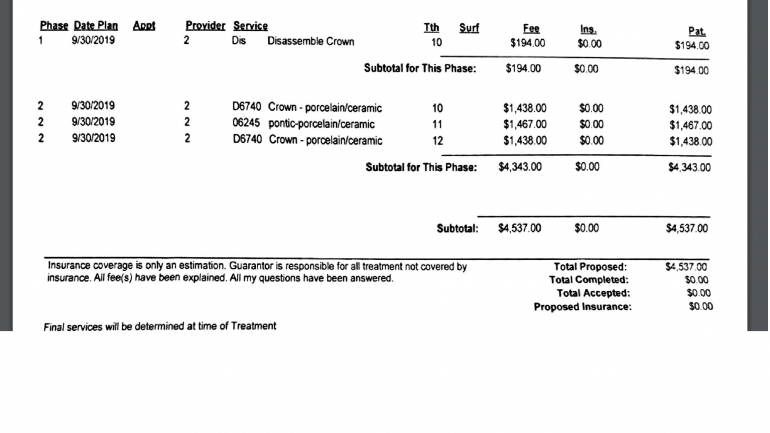
D0150: comprehensive oral evaluation - new or established patient
The code D0150 stands for comprehensive oral evaluation. It is used to present the patient's dental history and includes a detailed clinical examination of the entire oral cavity. The doctor examines masticatory muscles, jaws, tissues and teeth. X-rays help assess oral health.
Price range for Dental Code D0150
On average, patients pay $87 for this D0150 service at the dentist's office, with as little as $60 charged for this in less expensive cities and as much as $126 in more expensive cities.
Low cost of living | Medium cost of living | High cost of living |
Memphis (Tennessee), Cincinnati (Ohio) | Miami (Florida), Denver (Colorado), Austin (Texas) | (New York (New York), San Francisco (California) |
$60 | $87 | $126 |
However, the price for the service D0150 depends not only on the region where you live, but also varies from dentist to dentist. Therefore, it makes sense to compare prices before choosing a dentist. The best way to do this price comparison is at Dr. BestPrice and save a lot of money.
The code D0150
The Code D0150, comprehensive oral evaluation, involves a complete examination of the oral cavity. The goal of this examination is always to develop the best possible treatment for the patient. Restore tooth structure and improve oral health. The D0150 is always performed on a first-time patient, and every three to five years on all other patients.
Examination results and diagnostic radiographs assist the dentist in making a diagnosis. They are then discussed together with the patient and enable him to realistically assess his or her current condition.
The examination is indispensable for every patient must be informed in detail before starting any treatment. He or she needs all the information about the current situation and options. During a comprehensive evaluation, the doctor may discover things that the patient has not even thought of. For example, that the constant toothache stems from tense chewing muscles, not from the teeth.
First part - Initial interview and preclinical examination
The interview always begins by asking the patient about his or her wishes or current complaints. The doctor thus obtains an overview of the patient's general condition. Some questions may seem irrelevant to dental health. But this is how the attending physician ensures that the patient - with other existing health problems - receives the right treatment. When was the last medical check-up, have there been any hospitalizations or surgeries? Does the patient have implants, is there a blood clotting disorder or are there psychological problems such as an anxiety disorder?
Part two - examination outside the mouth
Oral health does not begin with the teeth. The doctor will thoroughly inspect the entire masticatory system. The muscles of mastication will be carefully palpated. Examination of the chewing apparatus includes muscles in the jaw, temples, but also in the neck. Tense muscles can radiate over a large area and cause pain.
The doctor examines the temporomandibular joint. You will have to perform a series of movements. The joint is examined for pain-sensitive points. Does the jaw make clicking, or cracking sounds? How do you open and close your mouth? Do you sometimes wake up with pain in the jaw joint, or do you have trouble chewing?
Third part - examination inside the mouth
Now the inside of the mouth is examined. The doctor starts with the soft tissues of the cheeks and lips. Furthermore, the systematic examination includes the gums, tongue, floor of the mouth, palate and pharynx. Are all mucous membranes moist and pink? If the doctor discovers, for example, white or red lesions of the mucosa or bite marks on the chewing surface, a more detailed examination is performed.
Usually, a panoramic X-ray is taken before the dental examination. This gives the dentist an excellent overview of your teeth and all structures. Temporomandibular joints, jaw bones and the sinuses are shown. If necessary, the doctor can now focus on specific areas and take detailed images. Smaller X-rays show cavities, infections, damage to the root canal or crowns and fillings.
Based on these X-rays, the teeth, roots and surrounding structures are visually inspected in detail, and the teeth may also be palpated. Each tooth is checked individually, all findings, all existing and missing teeth are recorded. Which teeth have been treated, which have no findings? Have the wisdom teeth already broken through or been extracted? How is the interlocking of the upper and lower jaws when they bite together? Doctors often take pictures to document things that are not shown by the X-rays. These can be spots or dots on the teeth. If the patient wears dentures, the teeth are examined with and without dentures.
The discussion
The most important part for the patient is the discussion. The doctor will explain all findings and treatment options with you. Your wishes and necessary therapies must proceed in the logical order.
Performed completely and professionally, the D0150 examination supports a correct diagnosis, early prevention and successful treatment. The D0150 is painless and safe. It is the best way to quickly detect and effectively combat diseases in the mouth.
Prices vary between dentists. The procedure of the examination is fixed and run identically. Therefore, it is particularly worthwhile to compare the offers via Dr. BestPrice.
